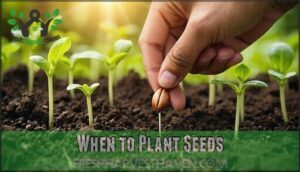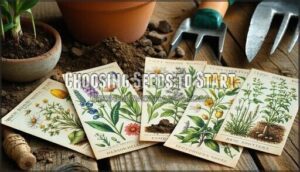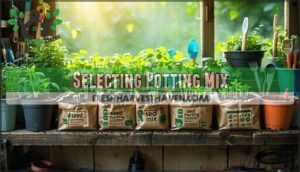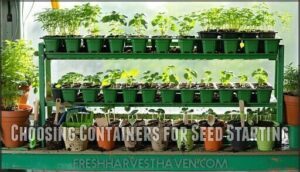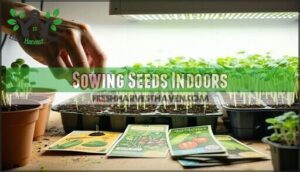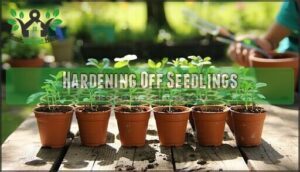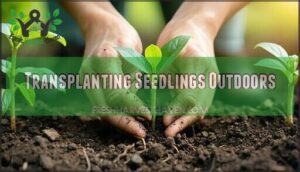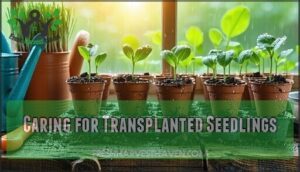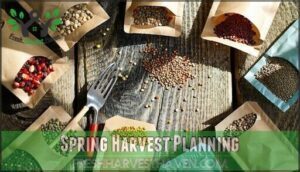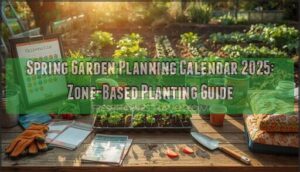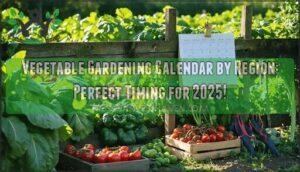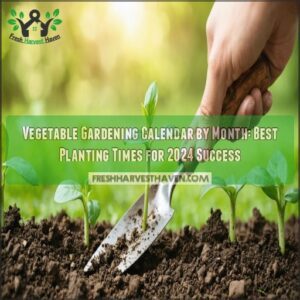This site is supported by our readers. We may earn a commission, at no cost to you, if you purchase through links.
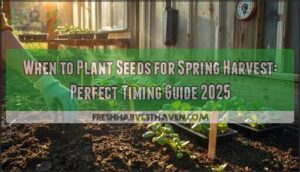
Start your cool-season crops like lettuce, spinach, and peas about 4-6 weeks before your last frost date.
You can direct sow these hardy vegetables outdoors when soil temperatures reach 40-50°F.
For warm-season crops like tomatoes and peppers, begin seeds indoors 6-8 weeks before the last frost, then transplant after danger has passed.
Cold-hardy vegetables such as kale and broccoli can handle light frosts, making them perfect early starters.
The secret isn’t just knowing when to plant seeds for spring harvest—it’s understanding your local climate patterns and soil conditions.
Table Of Contents
- Key Takeaways
- Seed Starting Basics
- When to Plant Seeds
- Choosing Seeds to Start
- Preparing Seeds for Indoors
- Transplanting Seedlings
- Spring Harvest Planning
- Frequently Asked Questions (FAQs)
- When should you plant seeds in a Spring Garden?
- When should you plant a vegetable garden?
- When should I start lettuce seeds?
- When should I start harvesting vegetables?
- When is early spring planting?
- When to start seeds indoors?
- . Why Should You Start Seeds indoors?
- . Which Seeds Should You Start indoors?
- . When Should You Start Seeds indoors?
- . When Should You Transplant seedlings?
- Conclusion
Key Takeaways
- Start cool-season crops 4-6 weeks before your last frost date – You can direct sow lettuce, spinach, and peas when soil hits 40-50°F, giving you earlier harvests than waiting for warm weather.
- Begin warm-season seeds indoors 6-8 weeks early – You’ll need to start tomatoes and peppers inside before transplanting them after frost danger passes, since they require consistent warmth to develop properly.
- Use soil temperature, not air temperature, as your planting guide – You should check soil temps with a thermometer rather than guessing, since seeds need specific temperature ranges to germinate successfully.
- Create a backward-counting schedule from your desired harvest date – You’ll avoid timing mistakes by marking your last frost date and counting backwards to determine when each crop needs to start indoors versus outdoors.
Seed Starting Basics
Starting seeds at the right time transforms your spring garden from a wishful thought into a thriving reality.
You’ll enjoy earlier harvests, stronger plants, and significant cost savings when you master the timing of indoor seed starting, which includes complete concepts like understanding the best time to start seeds for optimal growth.
Master seed starting timing and unlock earlier harvests, stronger plants, and serious savings.
Importance of Seed Starting
Success starts with smart seed starting decisions that transform your garden from ordinary to extraordinary.
When you start seeds indoors, you’re taking control of your growing season and setting yourself up for gardening victories that’ll make your neighbors jealous.
Indoor seed starting isn’t just about planting—it’s about creating the perfect foundation for thriving plants.
Your seed starting calendar becomes your roadmap to success, guiding you toward earlier harvests and extended seasons that maximize every square foot of garden space.
- Earlier Harvests – Beat the grocery store rush with homegrown tomatoes weeks ahead
- Extended Season – Stretch growing time from early spring through late fall
- Stronger Plants – Develop robust seedlings that handle transplant shock like champions
- Pest Resistance – Build natural defenses through controlled indoor environments
- Cost Savings – Transform penny seeds into pounds of premium produce
Benefits of Indoor Seed Starting
Starting seeds indoors gives you a serious advantage over outdoor planting.
Take control of your growing season and watch your garden transform from ordinary to extraordinary.
You’ll control every aspect of your seedlings’ environment while protecting them from unpredictable weather and pests.
Here’s what makes indoor seed starting worth your effort:
- Earlier Harvests & Extended Seasons: Get a 6-8 week head start, letting you harvest tomatoes and peppers when others are just transplanting
- Stronger Plants with Pest Resistance: Controlled conditions create robust seedlings that handle outdoor challenges better
- Cost Savings: Grow 50+ plants for what you’d spend on a few nursery transplants
Your seed starting calendar becomes your roadmap to success.
Remember to take into account the last frost date for ideal planting.
When to Plant Seeds
Perfect timing transforms seed starting from guesswork into a predictable path toward your spring harvest.
Your success depends on understanding when each type of seed needs to begin its journey indoors versus outdoors.
Seed Starting Dates for Vegetables
Planning your seed starting calendar requires knowing your local frost dates vegetables can tolerate. Frost Date Impact determines everything: tomatoes and peppers need 6-8 weeks indoors before transplanting, while lettuce requires just 4-6 weeks.
Regional Planting Variations mean Southern gardeners start earlier than Northern counterparts. Here’s your vegetable planting chart for when to sow seeds:
| Vegetable | Indoor Start Timing | Soil Temperature |
|---|---|---|
| Tomatoes | 6-8 weeks early | 60-70°F |
| Lettuce | 4-6 weeks early | 40-65°F |
| Peppers | 6-8 weeks early | 65-75°F |
Staggered Planting Timing extends harvests, while Calendar Tool Usage guarantees Harvest Date Prediction accuracy. For example, consider early spring indoor starting for celery.
Seed Starting Dates for Flowers
Timing transforms amateur gardening into expert cultivation when you’re flower seed starting. Most flowers need 6-10 weeks indoors before your last frost date, though Specific Flower Needs vary dramatically by variety.
Your flower seed starting schedule depends on Flower Germination Times and Bloom Time Targets:
- Fast bloomers (cosmos, zinnias): Start 6 weeks before last frost for quick results
- Slow starters (petunias, begonias): Begin 10-12 weeks early for established plants
- Perennials (delphinium): Start 12+ weeks before for first-year blooms
- Heat lovers (impatiens): Wait until 4-6 weeks before transplanting outdoors
- Cool-season flowers (pansies): Start earlier when soil temperatures stay above 55°F
Regional Flower Choices affect your timeline—northern gardeners start earlier indoors while southern regions can direct sow sooner. Light Requirements matter too; most seedlings need 12-16 hours daily under grow lights for healthy development.
Sowing Seeds by Temperature
Understanding soil temperature reveals perfect seed germination temperature success.
Cool-season crops germinate at 45-65°F, while warm-season plants need 65-85°F for optimal germination.
| Crop Type | Temperature Range | Equipment Needed |
|---|---|---|
| Cool-season | 45-65°F | Soil thermometer |
| Warm-season | 65-85°F | Heat mats recommended |
Heat mats maintain consistent soil warming for reliable results.
Check soil temperatures with thermometers—don’t guess!
Master temperature monitoring for optimal timing success.
Choosing Seeds to Start
Not all seeds thrive when started indoors, so you’ll want to choose wisely to maximize your spring harvest success.
Focus on vegetables like tomatoes, peppers, and broccoli that benefit from a head start, while leaving quick-growing crops like beans and radishes for direct outdoor sowing to ensure a successful harvest.
Vegetables to Start Indoors
Your indoor seed starting success depends on picking vegetables that’ll reward your early efforts with robust transplants.
Top vegetables to start indoors:
- Tomato varieties – Start 6-8 weeks before last frost for maximum growing time
- Pepper types – Need consistent warmth and benefit from extended indoor growth
- Broccoli timing – Cool-season crop that handles transplant shock well
- Eggplant needs – Requires long growing season, perfect for indoor head start
- Celery specifics – Takes 10-12 weeks to develop strong transplants
These vegetables love controlled indoor conditions where you can manage temperature, moisture, and lighting perfectly.
Flowers to Start Indoors
Your flower garden’s success starts with choosing the right blooms for indoor seed starting. Many flowers to start indoors need specific Starting Timeline considerations for ideal results.
Light Requirements Bloom Timing
Fragrant Varieties
Potting Choices matter for root development. Consider Hardening Flowers gradually before transplanting.
Following seed starting tips prevents Common Issues like damping-off disease during your spring planting guide schedule.
Seeds Requiring Specific Soil Temperatures
Your choice of flower varieties opens up another key consideration: matching seeds to proper soil temperatures for guaranteed success.
Soil thermometer use becomes your best friend when timing seed starting perfectly. Cool-season crops like lettuce thrive at 40-60°F, while warm-season vegetables need 60-85°F for ideal germination. Heat mat benefits include maintaining consistent temperatures that boost germination rates by up to 30%.
Regional soil warmth varies dramatically across planting zones, making temperature monitoring essential for your spring planting guide success. Seeds requiring temperature stratification needs, like some perennials, must experience specific cold periods before sprouting. A sterile seed starting mix can also help prevent diseases.
Here’s what proper temperature control delivers:
- Higher germination rates with faster sprouting
- Stronger seedlings that transplant successfully
- Reduced seed waste from failed attempts
- Predictable planting schedules you can count on
- Confidence in your seed starting tips application
Your germination temperature range knowledge transforms guesswork into reliable results, ensuring every planting seeds effort pays off with thriving seedlings.
Preparing Seeds for Indoors
Once you’ve chosen your seeds, you’ll need the right setup to give them their best start indoors.
The three essentials—quality potting mix, proper containers, and correct sowing technique—will determine whether your seedlings thrive or struggle from day one, which is crucial for their overall development and best start.
Selecting Potting Mix
Sterile mixes form the cornerstone of successful seedling development. You’ll want lightweight options that prevent disease while meeting essential drainage needs.
Quality seed starting mix offers excellent water retention without becoming soggy, plus proper nutrient content for emerging plants. You can even purchase pre-mixed options online.
Check pH balance stays between 6.0-7.0 for ideal germination. Organic options provide gentle, consistent nutrition that won’t burn tender roots during those critical first weeks.
Choosing Containers for Seed Starting
Perfect containers set the stage for thriving seedlings. Container size matters – cells should give roots room to grow without drowning in excess soil. Drainage needs are essential; holes prevent waterlogged conditions that kill young plants.
For container materials, plastic seed starting trays offer durability and reusability. Many gardeners find seed starting supplies essential for organization. Biodegradable pots let you transplant directly without disturbing roots. Upcycled containers like yogurt cups work great with added drainage holes.
Biodegradable options include peat pots and coconut fiber containers that decompose naturally. Drainage options range from pre-made holes to DIY punctures using nails or awls.
Choosing containers comes down to your budget, garden size, and transplanting preferences. Clean everything with diluted bleach before use.
Sowing Seeds Indoors
Once you’ve got your containers ready, it’s time to master sowing seeds indoors.
Success depends on three seed starting techniques:
- Plant at proper depth – sow seeds twice their diameter in quality seed starting mix
- Master watering techniques – keep soil consistently moist, never waterlogged
- Provide adequate indoor lighting – place under bright light for 14-16 hours daily
Container sterilization prevents germination issues before they start.
Using the correct seed starting medium is essential for successful germination.
Monitor seedling density to avoid overcrowding, which leads to weak plants and disease.
These seed starting basics create the foundation for healthy indoor seed starting that’ll give you strong transplants come spring.
Transplanting Seedlings
You’ve successfully started your seedlings indoors, and now they’re ready for the big move outdoors.
This critical move requires careful timing and proper technique to guarantee your plants thrive in their new environment.
Hardening Off Seedlings
Gradual acclimation transforms fragile indoor seedlings into garden-ready warriors. Start the hardening off process one week before transplanting seedlings. Begin with one hour outdoors daily, increasing exposure gradually. Weather monitoring guarantees you avoid harsh conditions during this critical timing duration.
| Day | Outdoor Time | Location Selection |
|---|---|---|
| 1-2 | 1-2 hours | Sheltered, shaded spot |
| 3-4 | 4-6 hours | Partial sun exposure |
| 5-7 | Full day | Direct sun location |
This hardening off seedlings approach prevents reducing shock while building resilience through weather considerations and proper seedling care.
Transplanting Seedlings Outdoors
Once your seedlings pass the hardening off seedlings test, it’s time for the main event.
Wait until soil temperatures hold steady above 60°F and your last frost date has safely passed.
Choose mild, overcast days with good weather conditions for transplanting.
Focus on soil preparation – loosen the ground and dig holes slightly wider than root balls.
Handle plants gently to minimize root disturbance, then apply thorough watering techniques immediately after planting.
Caring for Transplanted Seedlings
Once your seedlings settle into their new home, watering techniques become your daily ritual. Keep soil moist but not waterlogged—think damp sponge, not swimming pool.
Sun protection helps prevent wilting during hot afternoons. Watch for transplant shock signs like drooping leaves.
Light soil nutrients boost recovery, while consistent monitoring growth catches problems early. Using organic pest control can help protect them from early infestations.
Your caring for transplanted seedlings routine determines their success rate.
Spring Harvest Planning
Successfully planning your spring harvest starts with creating a detailed seed-starting schedule that works backward from your desired harvest dates.
You’ll avoid common timing mistakes and maximize your garden’s productivity by understanding when each crop needs to start indoors versus outdoors, which is crucial for a successful harvest.
Creating a Seed Starting Schedule
With your seedlings ready, you’ll need a smart schedule to maximize your spring harvest success.
Creating a seed starting schedule transforms chaotic planting into organized success. Your vegetable planting schedule becomes your roadmap for Calendar Integration and Task Prioritization throughout the growing season.
Build your spring garden planning system with these five steps:
- Mark your last frost date on a calendar for precise timing
- Count backwards from transplant dates for each spring vegetable seeds variety
- Plan succession planting every 2-3 weeks for continuous harvests
- Note regional adjustments that affect your local microclimate conditions
- Build schedule flexibility to handle weather surprises and delays
This approach eliminates guesswork while ensuring your seed starting efforts pay off with abundant harvests.
Planning for Optimal Harvest
Successful spring garden planning hinges on mastering harvest timing through strategic variety selection and climate adaptation.
Your planting calendar should incorporate staggered planting every two weeks for continuous yields.
| Planning Element | Timeline | Key Focus |
|---|---|---|
| Frost Dates | Track local data | Safe transplanting |
| Variety Selection | Match season length | Climate adaptation |
| Staggered Planting | Every 2-3 weeks | Extended harvest |
Monitor your vegetable planting schedule closely, adjusting spring vegetable seeds based on your region’s unique conditions for ideal spring harvest success.
Common Mistakes to Avoid in Seed Starting
With proper planning in place, avoid these seed starting pitfalls that can sabotage your spring harvest dreams.
4 Critical Mistakes That Kill Garden Dreams:
- Overwatering Seedlings – Use bottom watering to prevent damping-off disease and avoid disturbing delicate seeds like top watering does.
- Poor Lighting – Provide 14-16 hours of bright light daily to prevent weak, leggy growth that makes seedlings prone to failure.
- Neglecting Hardening – Gradually expose seedlings to outdoor conditions for one week before transplanting to prevent shock and mortality.
- Wrong Soil Temperature – Match soil warmth to seed requirements before sowing for successful germination rates.
Sterilizing containers and soil helps prevent diseases, promoting healthier growth, so consider baking soil at 180°F.
Frequently Asked Questions (FAQs)
When should you plant seeds in a Spring Garden?
Strike while the iron’s hot! You’ll want to plant cool-season crops like lettuce and peas four to six weeks before your area’s last frost date.
While warm-season vegetables need indoor starting six to eight weeks earlier, this difference in timing is critical to their success.
When should you plant a vegetable garden?
Plant your vegetable garden when soil temperatures reach 50-60°F and after your area’s last frost date.
Cool-season crops can go in 4-6 weeks before frost, while warm-season vegetables need warmer soil.
When should I start lettuce seeds?
Start lettuce seeds indoors 4-6 weeks before your last spring frost.
Or direct sow them outdoors as soon as you can work the soil—they’re tough little greens that handle cool weather like champs.
When should I start harvesting vegetables?
You’ll know it’s time to harvest when vegetables reach their prime size and color. Check seed packets for "Days to Harvest" timing, then taste-test for peak flavor and texture.
When is early spring planting?
Early spring planting typically begins when soil temperatures reach 40-60°F and you can work the ground, usually 4-6 weeks before your area’s last expected frost date.
When to start seeds indoors?
Timing matters more than you’d think. You’ll want to start cool-season crops like lettuce and spinach indoors 4-6 weeks before your last frost date, while warm-season vegetables need 6-8 weeks.
. Why Should You Start Seeds indoors?
Smart seedling strategies save you serious cash and cultivate stronger crops.
You’ll enjoy earlier harvests, extended growing seasons, better pest resistance, and healthier plants that’ll thrive in your garden all season long.
. Which Seeds Should You Start indoors?
Start tomatoes, peppers, eggplants, and broccoli indoors since they need longer growing seasons.
These heat-loving crops require warm soil temperatures that won’t arrive outdoors until well after your last frost date.
. When Should You Start Seeds indoors?
You’ll want to start seeds indoors 6-8 weeks before your last frost date.
Cool-season crops like lettuce need 4-6 weeks, while warm-season vegetables like tomatoes require the full 6-8 weeks for proper development.
. When Should You Transplant seedlings?
Don’t rush the process just because you’re enthusiastic to get planting!
You’ll transplant seedlings outdoors after the last frost date when soil temperatures stay consistently above 50°F and you’ve hardened them off gradually.
Conclusion
Apparently, rocket science is easier than figuring out when to plant seeds for spring harvest—at least rockets don’t care about frost dates.
But you’ve got this covered now. Your timing knowledge will transform those tiny seeds into a bountiful spring garden.
Remember, successful gardening isn’t about luck; it’s about understanding your climate and planning ahead. With proper timing, you’ll be harvesting fresh vegetables while your neighbors are still wondering when to plant seeds for spring harvest, and enjoying the fruits of your successful gardening.

